Ortiz de Montellano Paul R.(Ed.) Cytochrome P450. Structure, Mechanism, and Biochemistry
Подождите немного. Документ загружается.

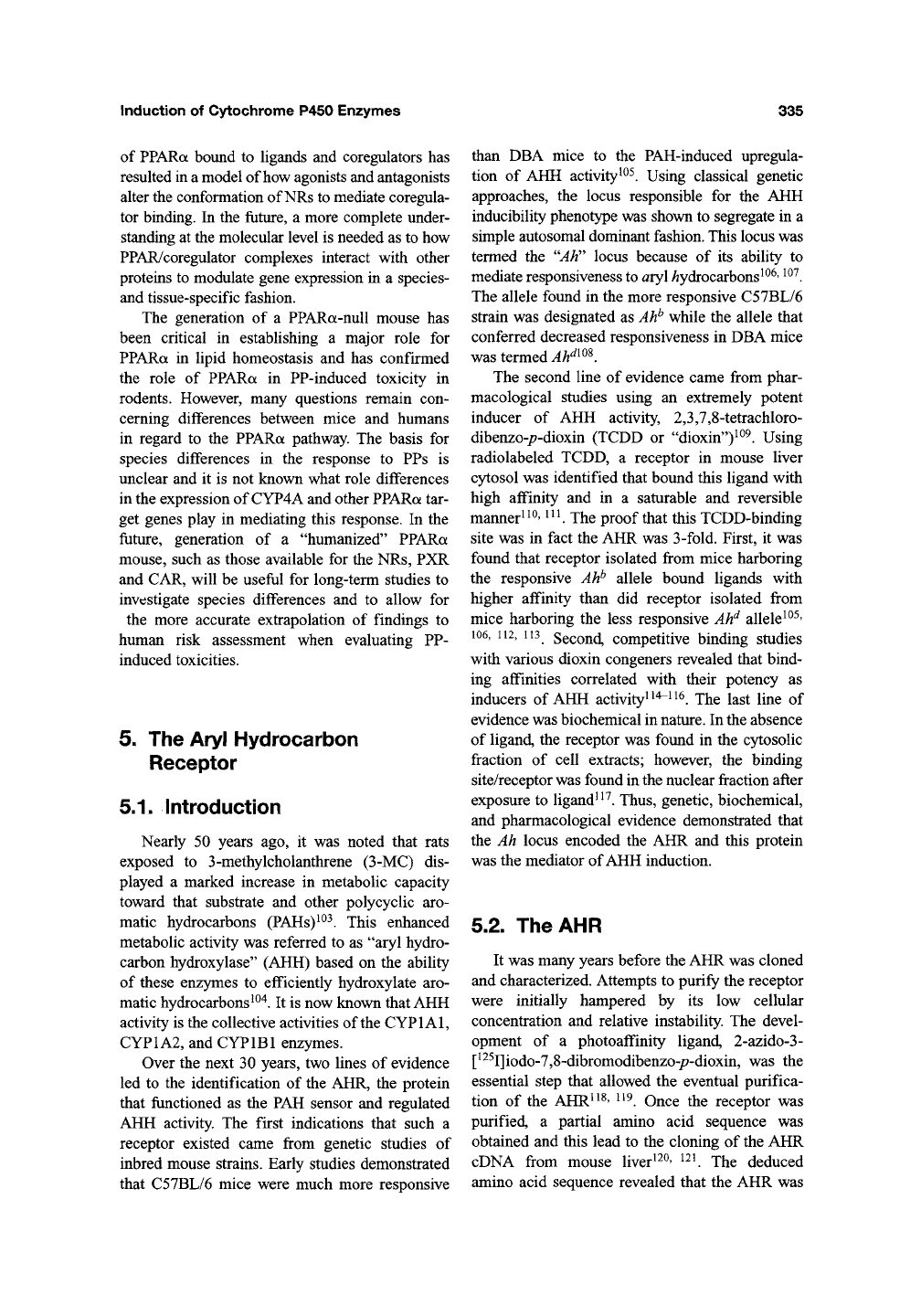
Induction of Cytochrome P450 Enzymes
335
of PPARa bound to ligands and coregulators has
resulted in a model of how agonists and antagonists
alter the conformation of NRs to mediate coregula-
tor binding. In the future, a more complete under-
standing at the molecular level is needed as to how
PPAR/coregulator complexes interact with other
proteins to modulate gene expression in a species-
and tissue-specific fashion.
The generation of a PPARa-null mouse has
been critical in establishing a major role for
PPARa in lipid homeostasis and has confirmed
the role of PPARa in PP-induced toxicity in
rodents. However, many questions remain con-
cerning differences between mice and humans
in regard to the PPARa pathway. The basis for
species differences in the response to PPs is
unclear and it is not known what role differences
in the expression of CYP4A and other PPARa tar-
get genes play in mediating this response. In the
future, generation of a "humanized" PPARa
mouse, such as those available for the NRs, PXR
and CAR, will be useful for long-term studies to
investigate species differences and to allow for
the more accurate extrapolation of findings to
human risk assessment when evaluating PP-
induced toxicities.
5. The Aryl Hydrocarbon
Receptor
5.1.
Introduction
Nearly 50 years ago, it was noted that rats
exposed to 3-methylcholantlirene (3-MC) dis-
played a marked increase in metabolic capacity
toward that substrate and other polycyclic aro-
matic hydrocarbons (PAHs)^^^. This enhanced
metabolic activity was referred to as "aryl hydro-
carbon hydroxylase" (AHH) based on the ability
of these enzymes to efficiently hydroxylate aro-
matic hydrocarbons ^^'^. It is now known that AHH
activity is the collective activities of the CYPlAl,
CYP1A2, and CYPIBI enzymes.
Over the next 30 years, two lines of evidence
led to the identification of the AHR, the protein
that functioned as the PAH sensor and regulated
AHH activity. The first indications that such a
receptor existed came from genetic studies of
inbred mouse strains. Early studies demonstrated
that C57BL/6 mice were much more responsive
than DBA mice to the PAH-induced upregula-
tion of AHH activity^^^. Using classical genetic
approaches, the locus responsible for the AHH
inducibility phenotype was shown to segregate in a
simple autosomal dominant fashion. This locus was
termed the ''Ah" locus because of its ability to
mediate responsiveness to
aryX
/hydrocarbons
^^^'
^^^.
The allele found in the more responsive C57BL/6
strain was designated as Ah^ while the allele that
conferred decreased responsiveness in DBA mice
was termed
^Z^'^^^^.
The second line of evidence came from phar-
macological studies using an extremely potent
inducer of AHH activity, 2,3,7,8-tetrachloro-
dibenzo-/7-dioxin (TCDD or "dioxin")^^^. Using
radiolabeled TCDD, a receptor in mouse liver
cytosol was identified that bound this ligand with
high affinity and in a saturable and reversible
manner^i^' ^^^ The proof that this TCDD-binding
site was in fact the AHR was 3-fold. First, it was
found that receptor isolated from mice harboring
the responsive Ahf^ allele bound ligands with
higher affinity than did receptor isolated from
mice harboring the less responsive Ah^ allele^^^'
106,
112, 113 Second, competitive binding studies
with various dioxin congeners revealed that bind-
ing affinities correlated with their potency as
inducers of AHH activity^
^'^^^^.
The last line of
evidence was biochemical in
nature.
In the absence
of ligand, the receptor was found in the cytosolic
fraction of cell extracts; however, the binding
site/receptor was found in the nuclear fraction after
exposure to ligand^ ^^. Thus, genetic, biochemical,
and pharmacological evidence demonstrated that
the Ah locus encoded the AHR and this protein
was the mediator of AHH induction.
5.2. The AHR
It was many years before the AHR was cloned
and characterized. Attempts to purify the receptor
were initially hampered by its low cellular
concentration and relative instability. The devel-
opment of a photoaffinity ligand, 2-azido-3-
[^^^I]iodo-7,8-dibromodibenzo-p-dioxin, was the
essential step that allowed the eventual purifica-
tion of the AHR^^^' ^^^. Once the receptor was
purified, a partial amino acid sequence was
obtained and this lead to the cloning of the AHR
cDNA from mouse liver^^^' ^^^ The deduced
amino acid sequence revealed that the AHR was
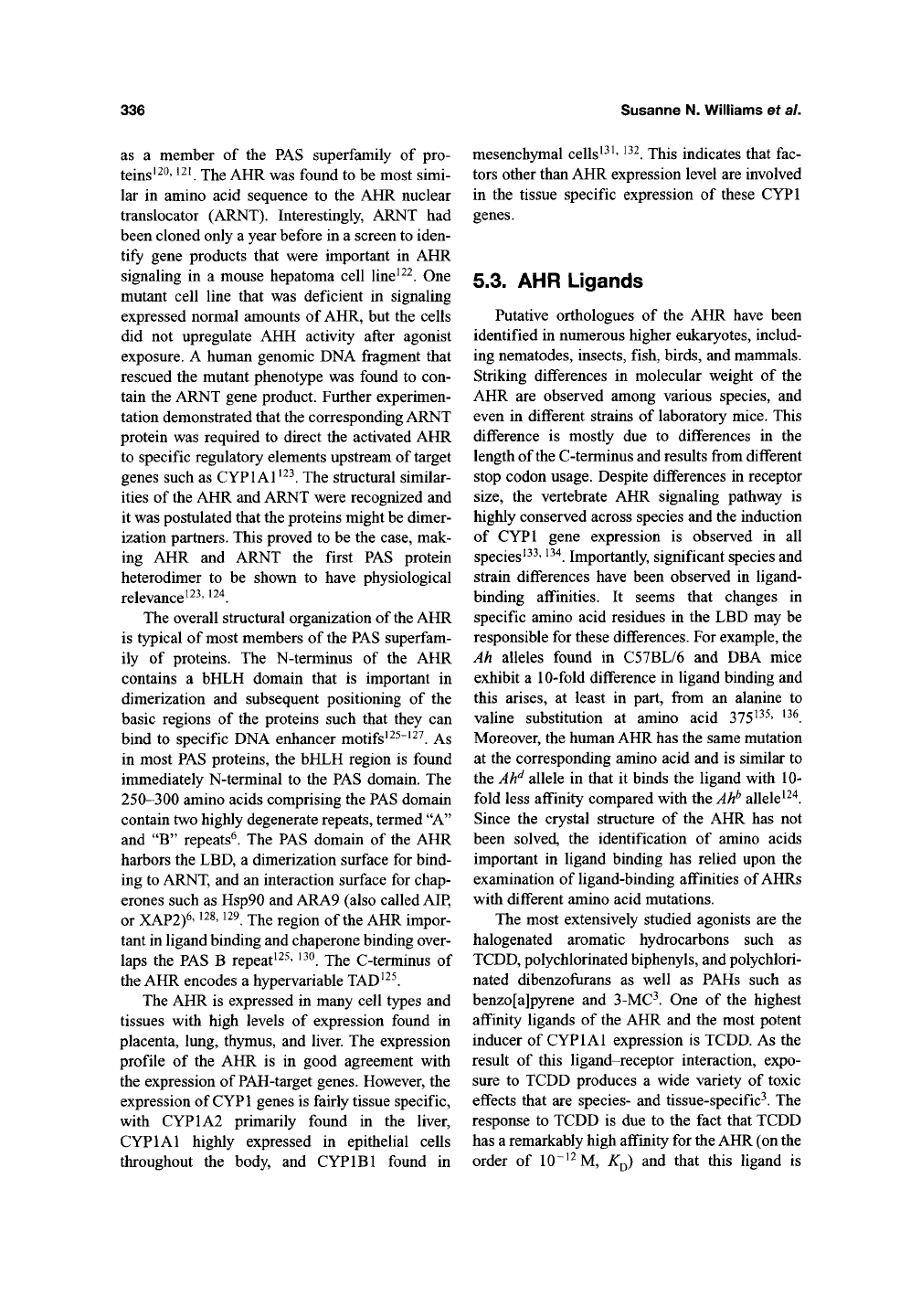
336
Susanne N. Williams et al.
as a member of the PAS superfamily of pro-
teins
^^°'
^^^ The AHR was found to be most simi-
lar in amino acid sequence to the AHR nuclear
translocator (ARNT). Interestingly, ARNT had
been cloned only a year before in a screen to iden-
tify gene products that were important in AHR
signaling in a mouse hepatoma cell line^^^. One
mutant cell line that was deficient in signaling
expressed normal amounts of AHR, but the cells
did not upregulate AHH activity after agonist
exposure. A human genomic DNA fragment that
rescued the mutant phenotype was found to con-
tain the ARNT gene product. Further experimen-
tation demonstrated that the corresponding ARNT
protein was required to direct the activated AHR
to specific regulatory elements upstream of target
genes such as CYPlAl^^^. The structural similar-
ities of the AHR and ARNT were recognized and
it was postulated that the proteins might be dimer-
ization partners. This proved to be the case, mak-
ing AHR and ARNT the first PAS protein
heterodimer to be shown to have physiological
relevance^^^'
^^^.
The overall structural organization of the AHR
is typical of most members of the PAS superfam-
ily of proteins. The N-terminus of the AHR
contains a bHLH domain that is important in
dimerization and subsequent positioning of the
basic regions of the proteins such that they can
bind to specific DNA enhancer motifs^^^~^^^. As
in most PAS proteins, the bHLH region is found
immediately N-terminal to the PAS domain. The
250-300 amino acids comprising the PAS domain
contain two highly degenerate repeats, termed "A"
and "B" repeats^. The PAS domain of the AHR
harbors the LBD, a dimerization surface for bind-
ing to ARNT, and an interaction surface for chap-
erones such as Hsp90 and ARA9 (also called AIP,
or XAP2)6' *28.129 j^Q
^egJQj^
^f^y^^ AHR jj^p^^.
tant in ligand binding and chaperone binding over-
laps the PAS B repeat^25, no
J^IQ
C-terminus of
the AHR encodes a hypervariable TAD*^^.
The AHR is expressed in many cell types and
tissues with high levels of expression found in
placenta, lung, thymus, and liver. The expression
profile of the AHR is in good agreement with
the expression of PAH-target genes. However, the
expression of CYPl genes is fairly tissue specific,
with CYP1A2 primarily found in the liver,
CYPlAl highly expressed in epithelial cells
throughout the body, and CYPIBI found in
mesenchymal cells^^^'
^^^.
This indicates that fac-
tors other than AHR expression level are involved
in the tissue specific expression of these CYPl
genes.
5.3. AHR Ligands
Putative orthologues of the AHR have been
identified in numerous higher eukaryotes, includ-
ing nematodes, insects, fish, birds, and mammals.
Striking differences in molecular weight of the
AHR are observed among various species, and
even in different strains of laboratory mice. This
difference is mostly due to differences in the
length of the C-terminus and results from different
stop codon usage. Despite differences in receptor
size,
the vertebrate AHR signaling pathway is
highly conserved across species and the induction
of CYPl gene expression is observed in all
species•^^'
^^'^.
Importantly, significant species and
strain differences have been observed in ligand-
binding affinities. It seems that changes in
specific amino acid residues in the LBD may be
responsible for these differences. For example, the
Ah alleles found in C57BL/6 and DBA mice
exhibit a 10-fold difference in ligand binding and
this arises, at least in part, from an alanine to
valine substitution at amino acid
375^^^'
^^^.
Moreover, the human AHR has the same mutation
at the corresponding amino acid and is similar to
the Ah^ allele in that it binds the ligand with 10-
fold less affinity compared with the Ah^ allele^^'^.
Since the crystal structure of the AHR has not
been solved, the identification of amino acids
important in ligand binding has relied upon the
examination of ligand-binding affinities of AHRs
with different amino acid mutations.
The most extensively studied agonists are the
halogenated aromatic hydrocarbons such as
TCDD, polychlorinated biphenyls, and polychlori-
nated dibenzofiirans as well as PAHs such as
benzo[a]pyrene and 3-MC^. One of the highest
affinity ligands of the AHR and the most potent
inducer of CYPl Al expression is TCDD. As the
result of this ligand-receptor interaction, expo-
sure to TCDD produces a wide variety of toxic
effects that are species- and tissue-specific^. The
response to TCDD is due to the fact that TCDD
has a remarkably high affinity for the AHR (on the
order of 10~^^M, K^) and that this ligand is
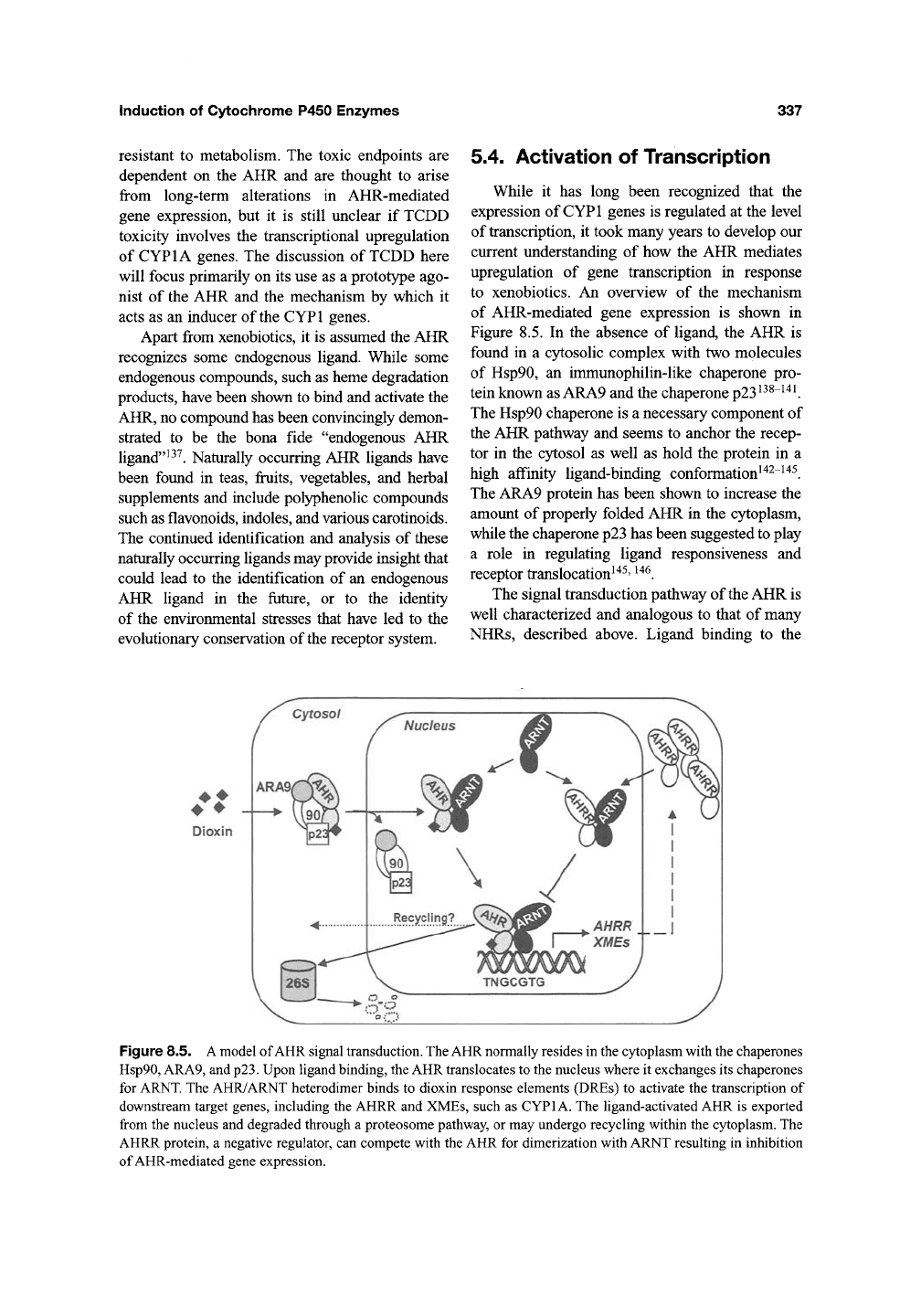
Induction of Cytochrome P450 Enzymes 337
resistant to metabolism. The toxic endpoints are
dependent on the AHR and are thought to arise
from long-term alterations in AHR-mediated
gene expression, but it is still unclear if TCDD
toxicity involves the transcriptional upregulation
of CYPIA genes. The discussion of TCDD here
will focus primarily on its use as a prototype ago-
nist of the AHR and the mechanism by which it
acts as an inducer of
the
CYPl genes.
Apart from xenobiotics, it is assumed the AHR
recognizes some endogenous ligand. While some
endogenous compounds, such as heme degradation
products, have been shown to bind and activate the
AHR, no compound has been convincingly demon-
strated to be the bona fide "endogenous AHR
ligand"^^^. Naturally occurring AHR ligands have
been found in teas, fruits, vegetables, and herbal
supplements and include polyphenolic compounds
such as flavonoids, indoles, and various carotinoids.
The continued identification and analysis of these
naturally occurring ligands may provide insight that
could lead to the identification of an endogenous
AHR ligand in the friture, or to the identity
of the environmental stresses that have led to the
evolutionary conservation of the receptor system.
5.4. Activation of Transcription
While it has long been recognized that the
expression of CYPl genes is regulated at the level
of transcription, it took many years to develop our
current understanding of how the AHR mediates
upregulation of gene transcription in response
to xenobiotics. An overview of the mechanism
of AHR-mediated gene expression is shown in
Figure 8.5. In the absence of ligand, the AHR is
found in a cytosolic complex with two molecules
of Hsp90, an immunophilin-like chaperone pro-
tein known as ARA9 and the chaperone
p23^^^~^'^^.
The Hsp90 chaperone is a necessary component of
the AHR pathway and seems to anchor the recep-
tor in the cytosol as well as hold the protein in a
high affinity ligand-binding conformation^^^"^"^^.
The ARA9 protein has been shown to increase the
amount of properly folded AHR in the cytoplasm,
while the chaperone p23 has been suggested to play
a role in regulating ligand responsiveness and
receptor translocation^'^^'
^^^.
The signal transduction pathway of the AHR is
well characterized and analogous to that of many
NHRs, described above. Ligand binding to the
Cytosol
Dioxin
ARi
Figure 8.5. A model of AHR signal transduction. The AHR normally resides in the cytoplasm with the chaperones
Hsp90, ARA9, and
p23.
Upon ligand binding, the AHR translocates to the nucleus where it exchanges its chaperones
for ARNT. The AHR/ARNT heterodimer binds to dioxin response elements (DREs) to activate the transcription of
downstream target genes, including the AHRR and XMEs, such as CYPIA. The ligand-activated AHR is exported
from the nucleus and degraded through a proteosome pathway, or may undergo recycling within the cytoplasm. The
AHRR protein, a negative regulator, can compete with the AHR for dimerization with ARNT resulting in inhibition
of AHR-mediated gene expression.
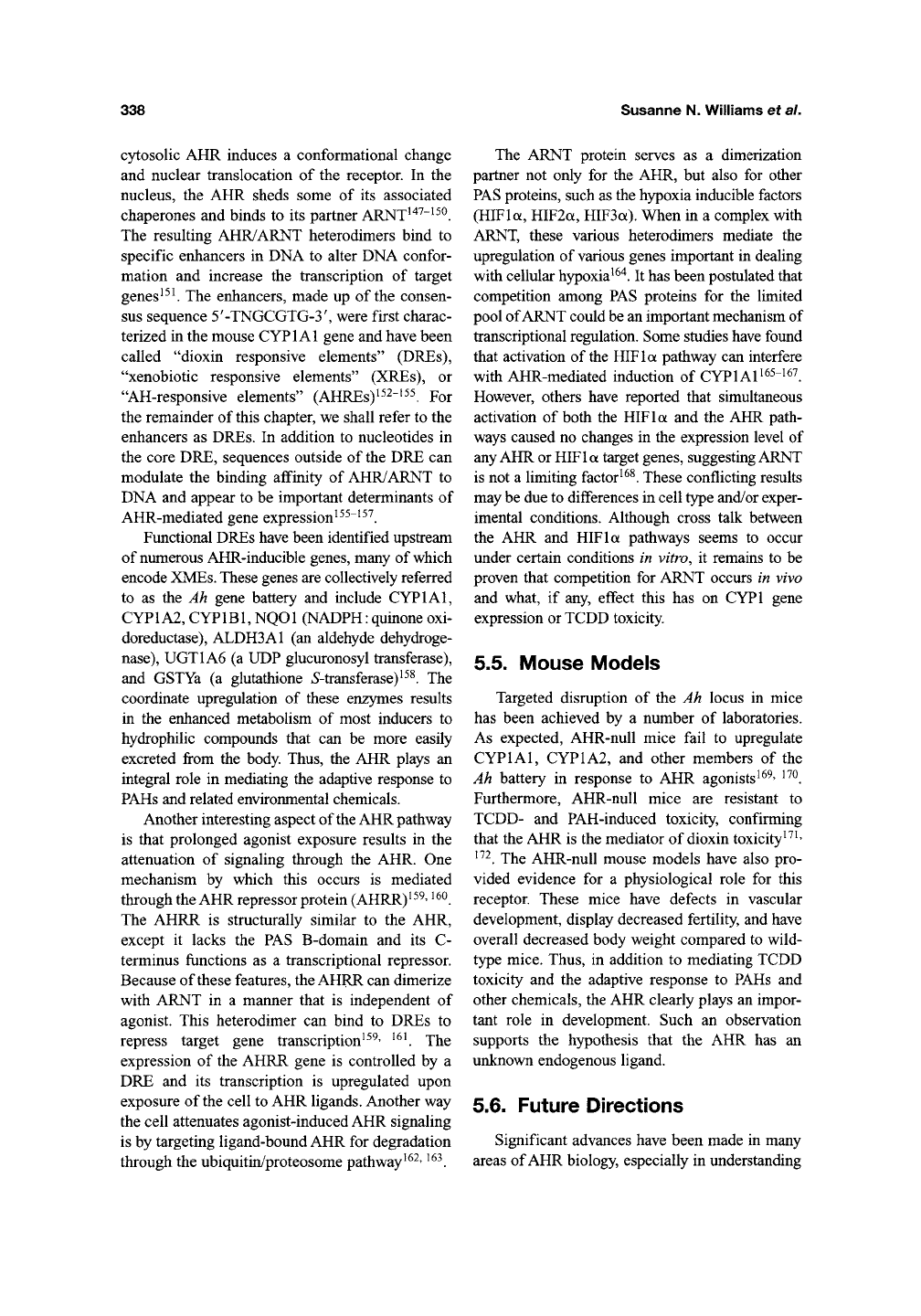
338 Susanne N. Williams ef a/.
cytosolic AHR induces a conformational change
and nuclear translocation of the receptor. In the
nucleus, the AHR sheds some of its associated
chaperones and binds to its partner ARNT^"^^"^^^.
The resulting AHR/ARNT heterodimers bind to
specific enhancers in DNA to alter DNA confor-
mation and increase the transcription of target
genes^^^
The enhancers, made up of the consen-
sus sequence 5'-TNGCGTG-3', were first charac-
terized in the mouse CYPlAl gene and have been
called "dioxin responsive elements" (DREs),
"xenobiotic responsive elements" (XREs), or
"AH-responsive elements" (AHREs)^^^"'^^. For
the remainder of
this
chapter, we shall refer to the
enhancers as DREs. In addition to nucleotides in
the core DRE, sequences outside of the DRE can
modulate the binding affinity of AHR/ARNT to
DNA and appear to be important determinants of
AHR-mediated gene expression^^^"^^^.
Functional DREs have been identified upstream
of numerous AHR-inducible genes, many of which
encode XMEs. These genes are collectively referred
to as the Ah gene battery and include CYPlAl,
CYPlA2, CYPIBI, NQOl (NADPH: quinone oxi-
doreductase), ALDH3A1 (an aldehyde dehydroge-
nase),
UGT1A6 (a UDP glucuronosyl transferase),
and GSTYa (a glutathione ^S-transferase)^^^. The
coordinate upregulation of these enzymes results
in the enhanced metabolism of most inducers to
hydrophilic compounds that can be more easily
excreted from the body. Thus, the AHR plays an
integral role in mediating the adaptive response to
EAHs and related environmental chemicals.
Another interesting aspect of
the
AHR pathway
is that prolonged agonist exposure results in the
attenuation of signaling through the AHR. One
mechanism by which this occurs is mediated
through the AHR repressor protein (AHRR)'^^' ^^^.
The AHRR is structurally similar to the AHR,
except it lacks the PAS B-domain and its C-
terminus functions as a transcriptional repressor.
Because of these features, the AHRR can dimerize
with ARNT in a manner that is independent of
agonist. This heterodimer can bind to DREs to
repress target gene transcription^^^' ^^'. The
expression of the AHRR gene is controlled by a
DRE and its transcription is upregulated upon
exposure of
the
cell to AHR ligands. Another way
the cell attenuates agonist-induced AHR signaling
is by targeting ligand-bound AHR for degradation
through the ubiquitin/proteosome pathway^^^' ^^^.
The ARNT protein serves as a dimerization
partner not only for the AHR, but also for other
PAS proteins, such as the hypoxia inducible factors
(HIFla, HIF2a, HIF3a). When in a complex with
ARNT, these various heterodimers mediate the
upregulation of various genes important in dealing
with cellular
hypoxia^^'^.
It has been postulated that
competition among PAS proteins for the limited
pool of ARNT could be an important mechanism of
transcriptional regulation. Some studies have found
that activation of the HIFla pathway can interfere
with AHR-mediated induction of CYPlAl ^^^i^l
However, others have reported that simultaneous
activation of both the HIFla and the AHR path-
ways caused no changes in the expression level of
any AHR or HIFla target genes, suggesting ARNT
is not a limiting factor^
^^.
These conflicting results
may be due to differences in cell type and/or exper-
imental conditions. Although cross talk between
the AHR and HIFla pathways seems to occur
under certain conditions in vitro, it remains to be
proven that competition for ARNT occurs in vivo
and what, if any, effect this has on CYPl gene
expression or TCDD toxicity.
5.5. Mouse Models
Targeted disruption of the Ah locus in mice
has been achieved by a number of laboratories.
As expected, AHR-null mice fail to upregulate
CYPlAl, CYP1A2, and other members of the
Ah battery in response to AHR agonists^^^' ^^^.
Furthermore, AHR-null mice are resistant to
TCDD- and PAH-induced toxicity, confirming
that the AHR is the mediator of dioxin toxicity^^^'
•^^. The AHR-null mouse models have also pro-
vided evidence for a physiological role for this
receptor. These mice have defects in vascular
development, display decreased fertility, and have
overall decreased body weight compared to wild-
type mice. Thus, in addition to mediating TCDD
toxicity and the adaptive response to PAHs and
other chemicals, the AHR clearly plays an impor-
tant role in development. Such an observation
supports the hypothesis that the AHR has an
unknown endogenous ligand.
5.6. Future Directions
Significant advances have been made in many
areas of AHR biology, especially in understanding
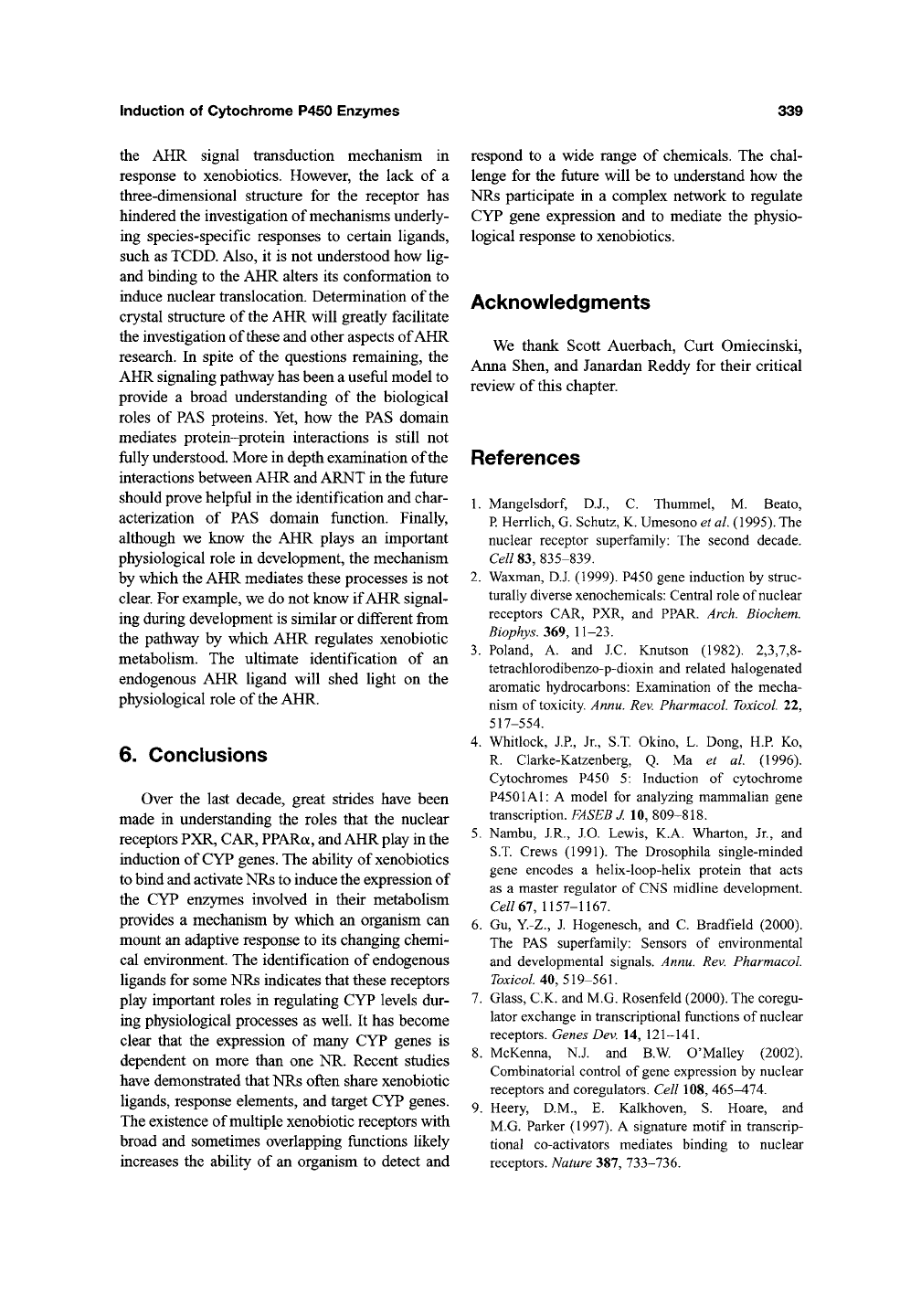
Induction of Cytochrome P450 Enzymes
339
the AHR signal transduction mechanism in
response to xenobiotics. However, the lack of a
three-dimensional structure for the receptor has
hindered the investigation of mechanisms underly-
ing species-specific responses to certain ligands,
such as TCDD. Also, it is not understood how lig-
and binding to the AHR alters its conformation to
induce nuclear translocation. Determination of the
crystal structure of the AHR will greatly facilitate
the investigation of these and other aspects of AHR
research. In spite of the questions remaining, the
AHR signaling pathway has been a useful model to
provide a broad understanding of the biological
roles of PAS proteins. Yet, how the R\S domain
mediates protein-protein interactions is still not
fully understood. More in depth examination of the
interactions between AHR and ARNT in the future
should prove helpful in the identification and char-
acterization of R\S domain function. Finally,
although we know the AHR plays an important
physiological role in development, the mechanism
by which the AHR mediates these processes is not
clear. For example, we do not know if AHR signal-
ing during development is similar or different from
the pathway by which AHR regulates xenobiotic
metabolism. The ultimate identification of an
endogenous AHR ligand will shed light on the
physiological role of the AHR.
6. Conclusions
Over the last decade, great strides have been
made in understanding the roles that the nuclear
receptors PXR, CAR, PEARa, and AHR play in the
induction of
CYP
genes. The ability of xenobiotics
to bind and activate NRs to induce the expression of
the CYP enzymes involved in their metabolism
provides a mechanism by which an organism can
mount an adaptive response to its changing chemi-
cal environment. The identification of endogenous
ligands for some NRs indicates that these receptors
play important roles in regulating CYP levels dur-
ing physiological processes as well. It has become
clear that the expression of many CYP genes is
dependent on more than one NR. Recent studies
have demonstrated that NRs oflen share xenobiotic
ligands, response elements, and target CYP genes.
The existence of multiple xenobiotic receptors with
broad and sometimes overlapping functions likely
increases the ability of an organism to detect and
respond to a wide range of chemicals. The chal-
lenge for the future will be to understand how the
NRs participate in a complex network to regulate
CYP gene expression and to mediate the physio-
logical response to xenobiotics.
Acknowledgments
We thank Scott Auerbach, Curt Omiecinski,
Anna Shen, and Janardan Reddy for their critical
review of this chapter.
References
1.
Mangelsdorf,
D.J., C. Thummel, M. Beato,
P.
Herrlich, G. Schutz,
K.
Umesono
et
al
(1995).
The
nuclear receptor superfamily: The second decade.
Cell
83,
835-839.
2.
Waxman, D.J. (1999). P450 gene induction by struc-
turally diverse
xenochemicals:
Central role of nuclear
receptors CAR, PXR, and PPAR. Arch. Biochem.
Biophys.
369,
11-23.
3.
Poland, A. and J.C. Knutson (1982). 2,3,7,8-
tetrachlorodibenzo-p-dioxin and related halogenated
aromatic hydrocarbons: Examination of the mecha-
nism of
toxicity.
Annu.
Rev.
Pharmacol.
Toxicol.
22,
517-554.
4.
Whitlock, J.R, Jr., S.T Okino, L. Dong, H.R Ko,
R. Clarke-Katzenberg, Q. Ma et al. (1996).
Cytochromes P450 5: Induction of cytochrome
P4501A1:
A model for analyzing mammalian gene
transcription.
FASEB
J.
10, 809-818.
5.
Nambu, J.R., J.O. Lewis, K.A. Wharton, Jr., and
S.T. Crews (1991). The Drosophila single-minded
gene encodes a helix-loop-helix protein that acts
as a master regulator of
CNS
midline development.
Cell
61,
1157-1167.
6. Gu, Y.-Z., J. Hogenesch, and C. Bradfield (2000).
The PAS superfamily: Sensors of environmental
and developmental signals.
Annu.
Rev.
Pharmacol.
Tox/co/. 40,519-561.
7.
Glass, C.K. and
M.G.
Rosenfeld
(2000).
The coregu-
lator exchange in transcriptional functions of nuclear
receptors.
Genes
Dev.
14,
121-141.
8. McKenna, N.J. and B.W. O'Malley (2002).
Combinatorial control of
gene
expression by nuclear
receptors and coregulators.
Cell
108,
465^74.
9. Heery, D.M., E. Kalkhoven, S. Hoare, and
M.G. Parker (1997). A signature motif in transcrip-
tional co-activators mediates binding to nuclear
receptors.
Nature
387,
733-736.
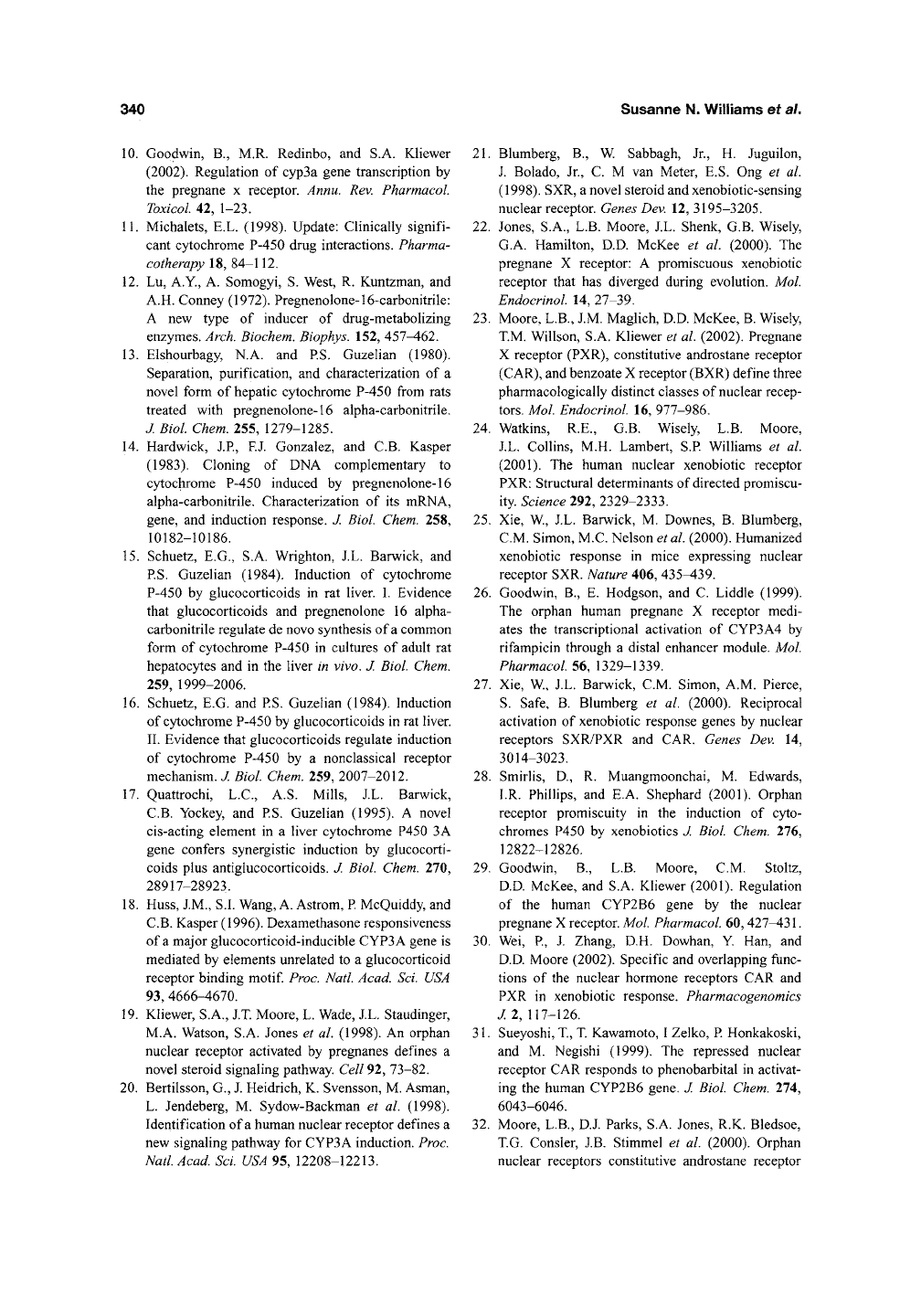
340
Susanne N. Williams ef a/.
10.
Goodwin, B., M.R. Redinbo, and S.A. Kliewer
(2002).
Regulation of cyp3a gene transcription by
the pregnane x receptor. Annu. Rev. Pharmacol.
Toxicol.
42, 1-23.
11.
Michalets, E.L. (1998). Update: Clinically signifi-
cant cytochrome P-450 drug interactions. Pharma-
cotherapy IS, 84-112.
12.
Lu, A.Y., A. Somogyi, S. West, R. Kuntzman, and
A.H. Conney (1972). Pregnenolone-16-carbonitrile:
A new type of inducer of drug-metabolizing
enzymes. Arch. Biochem. Biophys. 152, A51-A62.
13.
Elshourbagy, N.A. and RS. Guzelian (1980).
Separation, purification, and characterization of a
novel form of hepatic cytochrome P-450 from rats
treated with pregnenolone-16 alpha-carbonitrile.
J. Biol. Chem. 255, 1279-1285.
14.
Hardwick, J.P, F.J. Gonzalez, and C.B. Kasper
(1983).
Cloning of DNA complementary to
cytochrome P-450 induced by pregnenolone-16
alpha-carbonitrile. Characterization of its mRNA,
gene,
and induction response. J. Biol. Chem. 258,
10182-10186.
15.
Schuetz, E.G., S.A. Wrighton, J.L. Barwick, and
P.S.
Guzelian (1984). Induction of cytochrome
P-450 by glucocorticoids in rat liver. I. Evidence
that glucocorticoids and pregnenolone 16 alpha-
carbonitrile regulate de novo synthesis of a common
form of cytochrome P-450 in cultures of adult rat
hepatocytes and in the liver in vivo. J. Biol. Chem.
259,
1999-2006.
16.
Schuetz, E.G. and PS. GuzeHan (1984). Induction
of cytochrome P-450 by glucocorticoids in rat liver.
II.
Evidence that glucocorticoids regulate induction
of cytochrome P-450 by a nonclassical receptor
mechanism. J. Biol. Chem. 259, 2007-2012.
17.
Quattrochi, L.C., A.S. Mills, J.L. Barwick,
C.B. Yockey, and PS. Guzelian (1995). A novel
cis-acting element in a liver cytochrome P450 3A
gene confers synergistic induction by glucocorti-
coids plus antiglucocorticoids. J. Biol. Chem. 270,
28917-28923.
18.
Huss, J.M., S.I. Wang, A. Astrom, P McQuiddy, and
C.B. Kasper (1996). Dexamethasone responsiveness
of
a
major glucocorticoid-inducible CYP3A gene is
mediated by elements unrelated to a glucocorticoid
receptor binding motif Proc. Natl.
Acad.
Sci. USA
93,
4666^670.
19.
Kliewer, S.A., J.T. Moore, L. Wade, J.L. Staudinger,
M.A. Watson, S.A. Jones et al. (1998). An orphan
nuclear receptor activated by pregnanes defines a
novel steroid signaling pathway. Cell 92, 73-82.
20.
Bertilsson, G., J. Heidrich, K. Svensson, M. Asman,
L. Jendeberg, M. Sydow-Backman et al. (1998).
Identification of a human nuclear receptor defines a
new signaling pathway for CYP3A induction. Proc.
Natl.
Acad.
Sci. USA 95, 12208-12213.
21.
Blumberg, B., W Sabbagh, Jr., H. Juguilon,
J. Bolado, Jr., C. M van Meter, E.S. Ong et al.
(1998).
SXR, a novel steroid and xenobiotic-sensing
nuclear receptor. Genes
Dev.
12, 3195-3205.
22.
Jones, S.A., L.B. Moore, J.L. Shenk, G.B. Wisely,
G.A. Hamilton, D.D. McKee et al. (2000). The
pregnane X receptor: A promiscuous xenobiotic
receptor that has diverged during evolution. Mol.
Endocrinol. 14, 27-39.
23.
Moore, L.B., J.M. Maglich, D.D. McKee, B. Wisely,
T.M. Willson, S.A. Kliewer et al. (2002). Pregnane
X receptor (PXR), constitutive androstane receptor
(CAR),
and benzoate X receptor (BXR) define three
pharmacologically distinct classes of nuclear recep-
tors.
Mol. Endocrinol. 16, 977-986.
24.
Watkins, R.E., G.B. Wisely, L.B. Moore,
J.L. Collins, M.H. Lambert, S.P Williams et al
(2001).
The human nuclear xenobiotic receptor
PXR: Structural determinants of directed promiscu-
ity. Science 292, 2329-2333.
25.
Xie, W, J.L. Barwick, M. Downes, B. Blumberg,
CM. Simon, M.C. Nelson et al. (2000). Humanized
xenobiotic response in mice expressing nuclear
receptor SXR. Nature 406, 435^39.
26.
Goodwin, B., E. Hodgson, and C. Liddle (1999).
The orphan human pregnane X receptor medi-
ates the transcriptional activation of CYP3A4 by
rifampicin through a distal enhancer module. Mol.
Pharmacol. 56, 1329-1339.
27.
Xie, W, J.L. Barwick, CM. Simon, A.M. Pierce,
S. Safe, B. Blumberg et al. (2000). Reciprocal
activation of xenobiotic response genes by nuclear
receptors SXR/PXR and CAR. Genes Dev 14,
3014-3023.
28.
Smirlis, D, R. Muangmoonchai, M. Edwards,
I.R. Phillips, and E.A. Shephard (2001). Orphan
receptor promiscuity in the induction of cyto-
chromes P450 by xenobiotics J. Biol. Chem. 276,
12822-12826.
29.
Goodwin, B., L.B. Moore, CM. Stoltz,
D.D. McKee, and S.A. Kliewer (2001). Regulation
of the human CYP2B6 gene by the nuclear
pregnane X receptor. Mol. Pharmacol. 60,427^31.
30.
Wei, P, J. Zhang, D.H. Dowhan, Y Han, and
D.D. Moore (2002). Specific and overlapping func-
tions of the nuclear hormone receptors CAR and
PXR in xenobiotic response. Pharmacogenomics
J. 2, 117-126.
31.
Sueyoshi, T, T. Kawamoto, I Zelko, P. Honkakoski,
and M. Negishi (1999). The repressed nuclear
receptor CAR responds to phenobarbital in activat-
ing the human CYP2B6 gene. J. Biol. Chem. 274,
6043-6046.
32.
Moore, L.B., D.J. Parks, S.A. Jones, R.K. Bledsoe,
T.G. Consler, J.B. Stimmel et al. (2000). Orphan
nuclear receptors constitutive androstane receptor
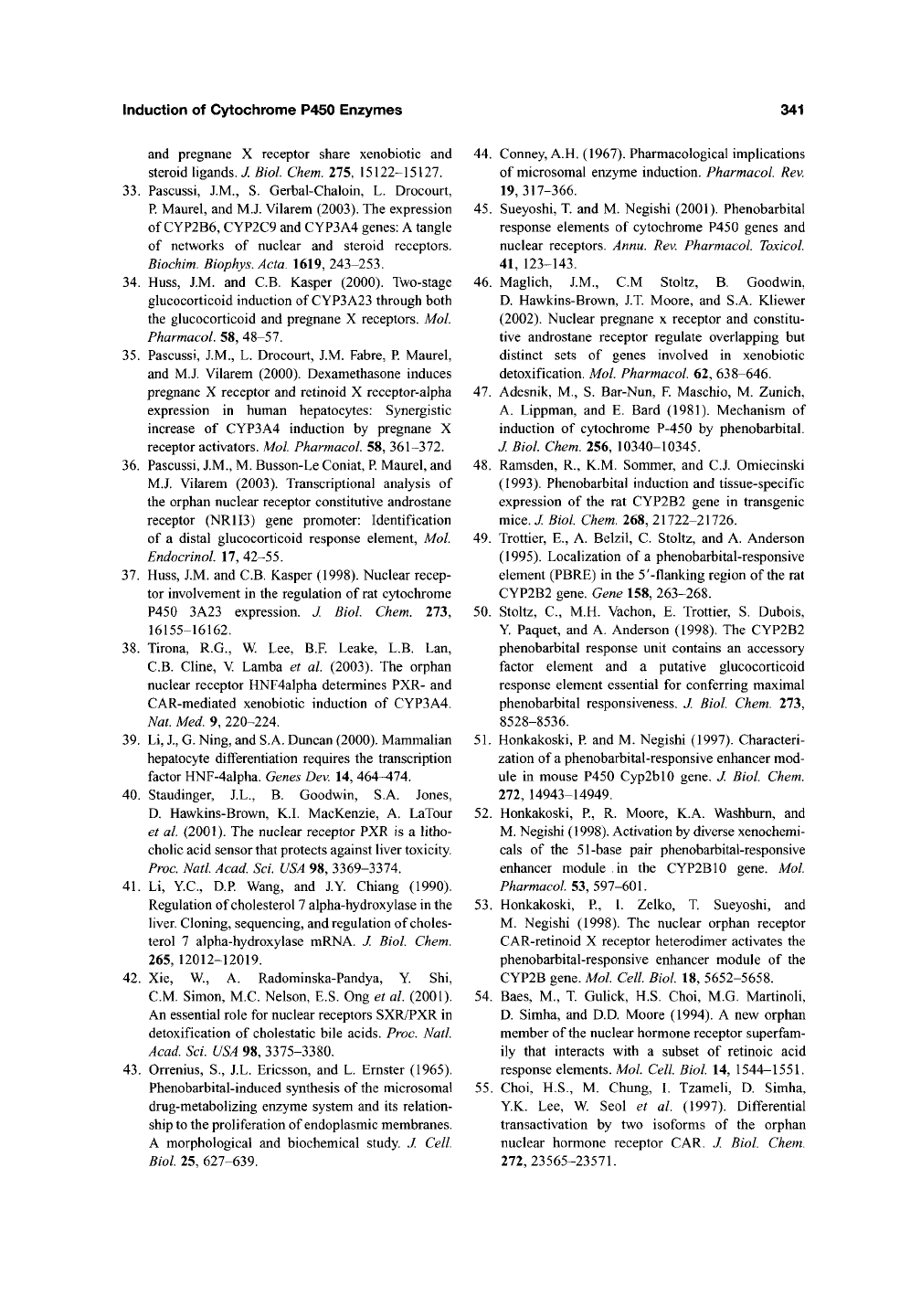
Induction of Cytochrome P450 Enzymes
341
and pregnane X receptor share xenobiotic and
steroid ligands. ^ 5/0/. Chem. 215, 15122-15127.
33.
Pascussi, J.M., S. Gerbal-Chaloin, L. Drocourt,
P.
Maurel, and M.J. Vilarem (2003). The expression
of CYP2B6, CYP2C9 and CYP3A4 genes: A tangle
of networks of nuclear and steroid receptors.
Biochim. Biophys. Acta. 1619, 243-253.
34.
Huss, J.M. and C.B. Kasper (2000). Two-stage
glucocorticoid induction of
CYP3A23
through both
the glucocorticoid and pregnane X receptors. Mol.
Pharmacol 58, 48-57.
35.
Pascussi, J.M., L. Drocourt, J.M. Fabre, P. Maurel,
and M.J. Vilarem (2000). Dexamethasone induces
pregnane X receptor and retinoid X receptor-alpha
expression in human hepatocytes: Synergistic
increase of CYP3A4 induction by pregnane X
receptor activators. Mol. Pharmacol. 58, 361-372.
36.
Pascussi, J.M., M. Busson-Le Coniat,
P.
Maurel, and
M.J. Vilarem (2003). Transcriptional analysis of
the orphan nuclear receptor constitutive androstane
receptor (NR1I3) gene promoter: Identification
of a distal glucocorticoid response element, Mol.
Endocrinol. 17, 42-55.
37.
Huss, J.M. and C.B. Kasper (1998). Nuclear recep-
tor involvement in the regulation of rat cytochrome
P450 3A23 expression. J. Biol. Chem. 113,
16155-16162.
38.
Tirona, R.G., W. Lee, B.F. Leake, L.B. Lan,
C.B. Cline, V Lamba et al. (2003). The orphan
nuclear receptor HNF4alpha determines PXR- and
CAR-mediated xenobiotic induction of CYP3A4.
Nat. Med. 9, 220-224.
39.
Li, J., G. Ning, and S.A. Duncan
(2000).
Mammalian
hepatocyte differentiation requires the transcription
factor HNF-4alpha. Genes
Dev.
14, 464-474.
40.
Staudinger, J.L., B. Goodwin, S.A. Jones,
D.
Hawkins-Brown, K.I. MacKenzie, A. LaTour
et al. (2001). The nuclear receptor PXR is a litho-
cholic acid sensor that protects against liver toxicity.
Proc. Natl. Acad Sci. USA 98, 3369-3374.
41.
Li, YC, D.R Wang, and J.Y. Chiang (1990).
Regulation of cholesterol 7 alpha-hydroxylase in the
liver. Cloning, sequencing, and regulation of choles-
terol 7 alpha-hydroxylase mRNA. J. Biol. Chem.
265,
12012-12019.
42.
Xie, W., A. Radominska-Pandya, Y Shi,
CM. Simon, M.C. Nelson, E.S. Ong et al. (2001).
An essential role for nuclear receptors SXR/PXR in
detoxification of cholestatic bile acids. Proc. Natl.
Acad Sci. USA 98, 3375-3380.
43.
Orrenius, S., J.L. Ericsson, and L. Emster (1965).
Phenobarbital-induced synthesis of the microsomal
drug-metabolizing enzyme system and its relation-
ship to the proliferation of endoplasmic membranes.
A morphological and biochemical study. J. Cell.
Biol. 25, 627-639.
44.
Conney, A.H. (1967). Pharmacological implications
of microsomal enzyme induction. Pharmacol. Rev.
19,317-366.
45.
Sueyoshi, T. and M. Negishi (2001). Phenobarbital
response elements of cytochrome P450 genes and
nuclear receptors. Annu. Rev. Pharmacol. Toxicol.
41,
123-143.
46.
Maglich, J.M., CM Stoltz, B. Goodwin,
D.
Hawkins-Brown, J.T. Moore, and S.A. Kliewer
(2002).
Nuclear pregnane x receptor and constitu-
tive androstane receptor regulate overlapping but
distinct sets of genes involved in xenobiotic
detoxification. Mol. Pharmacol. 62, 638-646.
47.
Adesnik, M., S. Bar-Nun, F. Maschio, M. Zunich,
A. Lippman, and E. Bard (1981). Mechanism of
induction of cytochrome P-450 by phenobarbital.
J. Biol. Chem. 256, 10340-10345.
48.
Ramsden, R., K.M. Sommer, and C.J. Omiecinski
(1993).
Phenobarbital induction and tissue-specific
expression of the rat CYP2B2 gene in transgenic
mice. J. Biol. Chem. 268, 21722-21726.
49.
Trottier, E., A. Belzil, C Stoltz, and A. Anderson
(1995).
Localization of a phenobarbital-responsive
element (PBRE) in the 5'-flanking region of the rat
CYP2B2 gene. Gene 158, 263-268.
50.
Stoltz, C, M.H. Vachon, E. Trottier, S. Dubois,
Y. Paquet, and A. Anderson (1998). The CYP2B2
phenobarbital response unit contains an accessory
factor element and a putative glucocorticoid
response element essential for conferring maximal
phenobarbital responsiveness. J. Biol. Chem. 273,
8528-8536.
51.
Honkakoski, P and M. Negishi (1997). Characteri-
zation of a phenobarbital-responsive enhancer mod-
ule in mouse P450 Cyp2bl0 gene. J. Biol. Chem.
272,
14943-14949.
52.
Honkakoski, P., R. Moore, K.A. Washburn, and
M. Negishi (1998). Activation by diverse xenochemi-
cals of the 51-base pair phenobarbital-responsive
enhancer module in the CYP2B10 gene. Mol.
Pharmacol. 53,591-601.
53.
Honkakoski, P., I. Zelko, T. Sueyoshi, and
M. Negishi (1998). The nuclear orphan receptor
CAR-retinoid X receptor heterodimer activates the
phenobarbital-responsive enhancer module of the
CYP2B gene. Mol. Cell. Biol. 18, 5652-5658.
54.
Baes, M., T. Guhck, H.S. Choi, M.G. Martinoli,
D.
Simha, and D.D. Moore (1994). A new orphan
member of the nuclear hormone receptor superfam-
ily that interacts with a subset of retinoic acid
response elements. Mol. Cell. Biol. 14, 1544-1551.
55.
Choi, H.S., M. Chung, I. TzameU, D. Simha,
YK. Lee, W Seol et al. (1997). Differential
transactivation by two isoforms of the orphan
nuclear hormone receptor CAR. J. Biol. Chem.
272,23565-23571.

342
Susanne N. Williams et al.
56.
Kawamoto, T., T. Sueyoshi, I. Zelko, R. Moore,
K. Washburn, and
M.
Negishi (1999). Phenobarbital-
responsive nuclear translocation of the receptor CAR
in induction of the CYP2B gene. Mol Cell. Biol. 19,
6318-6322.
57.
Zelko, I., T. Sueyoshi, T. Kawamoto, R. Moore, and
M. Negishi (2001). The peptide near the C terminus
regulates receptor CAR nuclear translocation
induced by xenochemicals in mouse liver. Mol. Cell.
Biol. 21, 2838-2846.
58.
Kawamoto, T., S. Kakizaki, K. Yoshinari, and
M. Negishi (2000). Estrogen activation of the
nuclear orphan receptor CAR (constitutive active
receptor) in induction of the mouse Cyp2bl0 gene.
Mol. Endocrinol. 14, 1897-1905.
59.
Forman, B.M., I. Tzameli, H.S. Choi, J. Chen,
D.
Simha,
W.
Seol et
al.
(1998). Androstane metabo-
lites bind to and deactivate the nuclear receptor
CAR-beta. Nature 395, 612-615.
60.
Tzameli, I., R Pissios, E.G. Schuetz, and
D.D. Moore (2000). The xenobiotic compound 1,4-
bis[2-(3,5-dichloropyridyloxy)]benzene is an ago-
nist ligand for the nuclear receptor CAR. Mol. Cell.
Biol. 20, 295\-295S.
61.
Maglich, J.M., D.J. Parks, L.B. Moore, J.L. Collins,
B.
Goodwin, A.N. Billin et al. (2003). Identification
of a novel human constitutive androstane receptor
(CAR) agonist and its use in the identification
of CAR target genes. J. Biol. Chem. 11%,
17277-17283.
62.
Dussault, I., M. Lin, K. HolHster, M Fan, J. Termini,
M.A. Sherman et al. (2002). A structural model of
the constitutive androstane receptor defines novel
interactions that mediate ligand-independent activ-
ity. Mol. Cell. Biol. 22, 5270-5280.
63.
Min, G., J.K. Kemper, and B. Kemper (2002).
Glucocorticoid receptor interacting protein-1
(GRIPI) mediates ligand-independent nuclear
translocation and activation of constitutive andro-
stane receptor (CAR) in vivo. J. Biol. Chem. Ill,
26356-26363.
64.
Wei, P, Zhang, J. Egan-Hafley, M. Liang, S. and
D.D. Moore (2000). The nuclear receptor CAR
mediates specific xenobiotic induction of drug
metabolism. Nature 407, 920-923.
65.
Ueda, A., H.K. Hamadeh, H.K Webb,
Y.
Yamamoto,
T. Sueyoshi, C.A. Afshari et al. (2002). Diverse
roles of the nuclear orphan receptor CAR in regu-
lating hepatic genes in response to Phenobarbital.
Mol. Pharmacol. 61, 1-6.
66.
Zhang, J., W Huang, S.S. Chua, P Wei, and
D.D. Moore (2002). Modulation of acetaminophen-
induced hepatotoxicity by the xenobiotic receptor
CAR. Science 298, All-AIA.
67.
Huang, W, J. Zhang, S.S. Chua, M. Qatanani,
Y Han, R. Granata et al. (2003). Induction of
bilirubin clearance by the constitutive androstane
receptor (CAR). Proc. Natl.
Acad.
Sci. USA 100,
4156^161.
68.
Reddy, J.K. and T. Hashimoto (2001). Peroxisomal
beta-oxidation and peroxisome proliferator-
activated receptor alpha: An adaptive metabolic
system. Annu. Rev. Nutr 21, 193-230.
69.
Johnson, E.E, M.H. Hsu, U. Savas, and K.J. Griffin
(2002).
Regulation of P450 4A expression by per-
oxisome proliferator activated receptors. Toxicology
181-182,
203-206.
70.
Owen, O.E., G.A. Reichard Jr., M.S. Patel, and
G. Boden (1979). Energy metabolism in feasting
and fasting. Adv. Exp. Med. Biol. Ill, 169-188.
71.
Reddy, J.K. andN.D. Lalwai (1983). Carcinogenesis
by hepatic peroxisome proliferators: Evaluation
of the risk of hypolipidemic drugs and industrial
plasticizers to humans. Crit. Rev.
Toxicol.
12, 1-58.
72.
Issemann, 1. and S. Green (1990). Activation of a
member of the steroid hormone receptor superfamily
by peroxisome proliferators. Nature 347, 645-650.
73.
GottHcher, M., E. Widmark, Q. Li, and
J.-A. Gustafsson (1992). Fatty acids activate a
chimera of the clofibric acid-activated receptor and
the glucocorticoid receptor. Proc. Natl.
Acad.
Sci.
USA 89, 4653-^657.
74.
Kliewer, S.A., B.M. Forman, B. Blumberg,
E.S.
Ong, U. Borgmeyer, D.J. Mangelsdorf et al.
(1994).
Differential expression and activation of a
family of murine peroxisome proliferator-activated
receptors.
Proc.
Natl.
Acad Sci.
USA
91, 7355-7359.
75.
Capdevila, J.H., R.C. Harris, and J.R. Falck (2002).
Microsomal cytochrome P450 and eicosanoid
metabolism. Cell. Mol. Life Sci. 59, 780-789.
76.
Willson, T.M., M.H. Lambert, and S.A. Kliewer
(2001).
Peroxisome proliferator-activated receptor
gamma and metabolic disease. Annu. Rev. Biochem.
70,341-367.
77.
Shi, Y, M. Hon, and R.M. Evans (2002). The per-
oxisome proliferator-activated receptor delta, an
integrator of transcriptional repression and nuclear
receptor signaling. Proc. Natl.
Acad.
Sci. USA 99,
2613-2618.
78.
Hess, R., W Staubli, and W Riess (1965). Nature
of the hepatomegalic effect produced by ethyl-
chlorophenoxy-isobutyrate in the rat. Nature 208,
856-858.
79.
Thorp, J.M. and WS Waring (1962). Modification
and distribution of lipids by ethylchlorophenoxy-
isobutyrate. Nature 194, 948-949.
80.
Corton, J.C, S.P Anderson, and A. Stauber (2000).
Central role of peroxisome proliferator-activated
receptors in the actions of peroxisome proliferators.
Annu. Rev. Pharmacol.
Toxicol.
40, 491-518.
81.
Issemann, I. and S. Green (1990). Activation of
a member of the steroid hormone receptor super-
family by peroxisome proliferators. Nature 347,
645-650.

Induction of Cytochrome P450 Enzymes
343
82.
Fan, C.Y., J. Pan, N. Usuda, A.V. Yeldandi,
M.S.
Rao, and J.K. Reddy (1998). Steatohepatitis,
spontaneous peroxisome proliferation and liver
tumors in mice lacking peroxisomal fatty acyl-CoA
oxidase. Implications for peroxisome proliferator-
activated receptor alpha natural ligand metabolism.
J. Biol. Chem. 273, 15639-15645.
83.
Kliewer, S.A., S.S. Sundseth, S.A. Jones,
RJ. Brown, G.B. Wisely, C.S. Koble et al (1997).
Fatty acids and eicosanoids regulate gene expres-
sion through direct interactions with peroxisome
proliferator-activated receptors alpha and gamma.
Proc. Natl.
Acad.
Sci. USA 94, 4318-4323.
84.
Forman, B.M., J. Chen, and R.M. Evans
(1997).
Hypolipidemic drugs, polyunsaturated fatty
acids,
and eicosanoids are ligands for peroxisome
proliferator-activated receptors alpha and delta,
Proc. Natl.
Acad.
Sci. USA 94, 4312-4317.
85.
Devchand, RR., H. Keller, J.M. Peters, M. Vazquez,
RJ. Gonzalez, and W. Wahli (1996). The
PPARalpha-leukotriene B4 pathway to inflamma-
tion control. Nature 384, 39^3.
86.
Marcus, S.L., K.S. Miyata, B. Zhang, S. Subramani,
R.A. Rachubinski, and J.R Capone (1993). Diverse
peroxisome proliferator-activated receptors bind to
the peroxisome proliferator-responsive elements of
the rat hydratase/dehydrogenase and fatty acyl-CoA
oxidase genes but differentially induce expression.
Proc. Natl. Acad Sci. USA 90, 5723-5727.
87.
Osumi, T., N. Ishii, S. Miyazawa, andT. Hashimoto
(1987).
Isolation and structural characterization of
the rat acyl-CoA oxidase gene. J. Biol. Chem. 262,
8138-8143.
88.
Issemann, I., R.A. Prince, J.D. Tugwood, and
S. Green (1993). The peroxisome proliferator-
activated receptor: retinoid X receptor heterodimer
is activated by fatty acids and fibrate hypolipi-
daemic drugs. J. Mol. Endocrinol. 11, 37^7.
89.
Kliewer, S.A., K. Umesono, D.J. Noonan,
R.A. Heyman, and R.M. Evans (1992). Conver-
gence of
9-cis
retinoic acid and peroxisome
prolif-
erator signalling pathways through heterodimer
formation of their receptors. Nature 358,11\-11A.
90.
Palmer, C.N., M.H. Hsu, H.J. Griffin, and
E.F.
Johnson (1995). Novel sequence determinants
in peroxisome proliferator signaling. J. Biol. Chem.
270,
16114-16121.
91.
Juge-Aubry, C, A. Pemin, T. Favez, A.G. Burger,
W. Wahli, C.A. Meier et al. (1997). DNA binding
properties of peroxisome proliferator-activated
receptor subt3^es on various natural peroxisome
proliferator response elements. Importance of
the 5'-flanking region. J. Biol. Chem. Ill,
25252-25259.
92.
Surapureddi, S., S. Yu, H. Bu, T. Hashimoto,
A.V Yeldandi, R Kashireddy et al. (2002). Identi-
fication of a transcriptionally active peroxisome
proliferator-activated receptor alpha-interacting
cofactor complex in rat liver and characterization
of PRIC285 as a coactivator. Proc. Natl.
Acad.
Sci.
USA 99, 11836-11841.
93.
Xu, H.E., M.H. Lambert, VG. Montana,
K.D.
Plunket, L.B. Moore, J.L. Collins et al.
(2001).
Structural determinants of ligand binding
selectivity between the peroxisome proliferator-
activated receptors. Proc. Natl.
Acad.
Sci. USA 98,
13919-13924.
94.
Xu, H.E., TN. Stanley, VG. Montana,
M.H. Lambert, B.G. Shearer, J.E. Cobb et al.
(2002).
Structural basis for antagonist-mediated
recruitment of nuclear co-repressors by
PPARalpha. Nature 415, 813-817.
95.
Peters, J.M., N. Hennuyer, B. Staels, J.C. Fruchart,
C. Fievet, F.J. Gonzalez et
al.
(1997). Alterations in
lipoprotein metabolism in peroxisome proliferator-
activated receptor alpha-deficient mice. J. Biol.
C/iem. 272, 27307-27312.
96.
Reddy, J.K., D.L.
Azarnoff;
and C.E. Hignite
(1980).
Hypolipidaemic hepatic peroxisome
proliferators form a novel class of chemical
carcinogens. Nature 283, 397-398.
97.
Palmer, C.N., M.H. Hsu, K.J. Griffin, J.L Raucy,
and E.F. Johnson (1998). Peroxisome proliferator
activated receptor-alpha expression in human liver.
Mol. Pharmacol. 53, 14-22.
98.
Gervois, R, I.R Torra, G. Chinetti, T. Grotzinger,
G. Dubois, J.C. Fruchart et al. (1999). A truncated
human peroxisome proliferator-activated receptor
alpha splice variant with dominant negative activ-
ity. Mol. Endocrinol. 13, 1535-1549.
99.
Yu, S., W.Q. Cao, R Kashireddy, K. Meyer,
Y.
Jia,
D.E. Hughes et al. (2001). Human peroxisome
proliferator-activated receptor alpha (PPARalpha)
supports the induction of peroxisome proliferation
in PPARalpha-deficient mouse liver.
J.
Biol. Chem.
276,42485-42491.
100.
Cherkaoui-Malki, M., K. Meyer, W.Q. Cao,
N.
Latruffe, A.V Yeldandi, M.S. Rao et al (2001).
Identification of novel peroxisome proliferator-
activated receptor alpha (PPARalpha) target genes
in mouse liver using cDNA microarray analysis.
GeneExpr 9,291-304.
101.
Lee, S.S., T. Pineau, J. Drago, E.J. Lee,
J.W. Owens, D.L. Kroetz et al (1995). Targeted
disruption of the alpha isoform of the peroxisome
proliferator-activated receptor gene in mice
results in abolishment of the pleiotropic effects of
peroxisome proliferators. Mol Cell. Biol 15,
3012-3022.
102.
Leone, TC, C.J. Weinheimer, and D.R Kelly
(1999).
A critical role for the peroxisome pro-
liferator-activated receptor alpha (PPARalpha)
in the cellular fasting response: The PPARalpha-
null mouse as a model of fatty acid oxidation
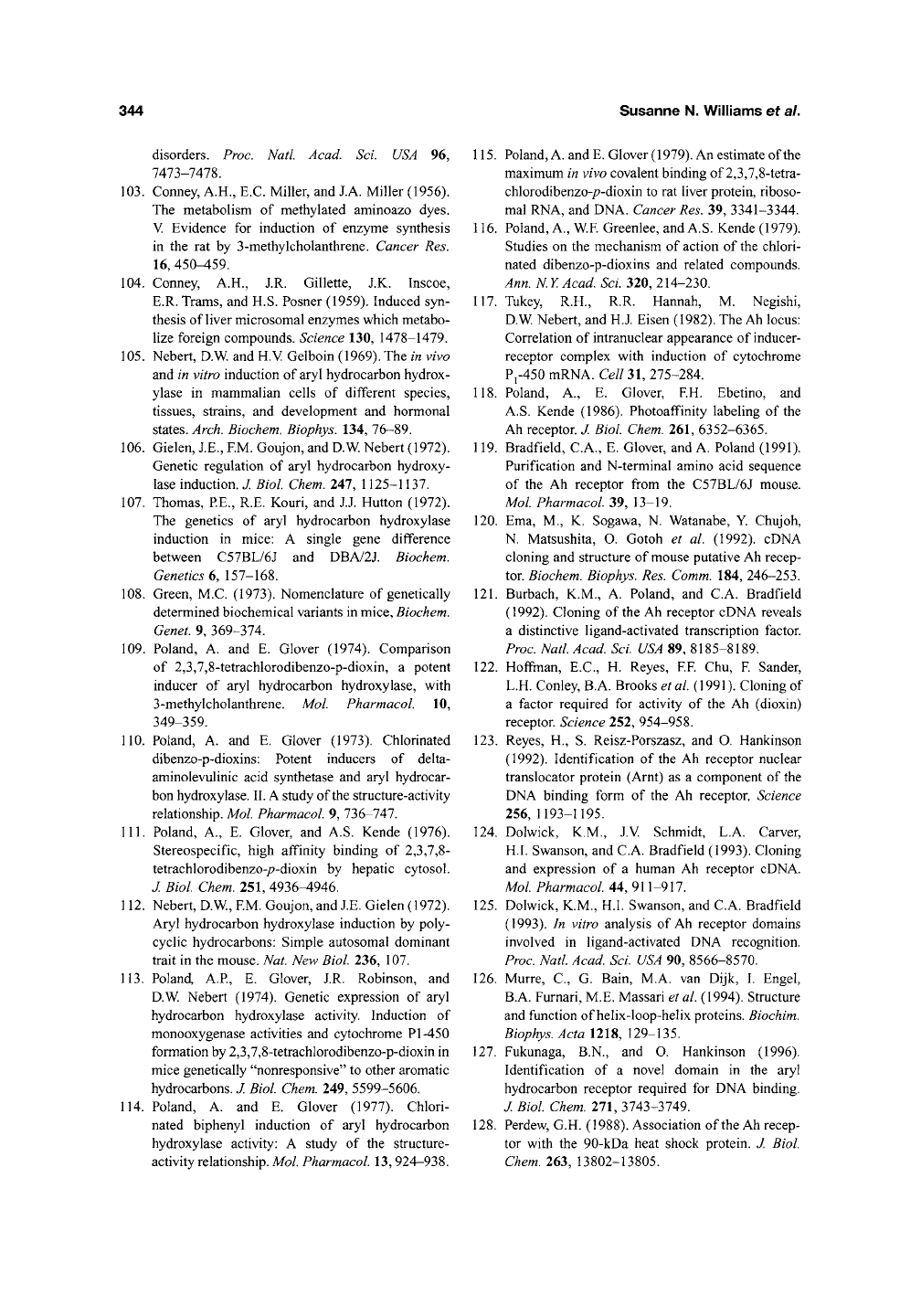
344
Susanne N. Williams et al.
disorders. Proc. Natl.
Acad.
Sci. USA 96,
7473-7478.
103.
Conney, A.H., E.C. Miller, and J.A. Miller (1956).
The metabolism of methylated aminoazo dyes.
V Evidence for induction of enzyme synthesis
in the rat by 3-methylcholanthrene. Cancer Res.
16,
450-459.
104.
Conney, A.H., J.R. Gillette, J.K. Inscoe,
E.R. Trams, and H.S. Posner (1959). Induced syn-
thesis of liver microsomal enzymes which metabo-
lize foreign compounds. Science 130, 1478-1479.
105.
Nebert, D.W. and H.V Gelboin (1969). The in vivo
and in vitro induction of aryl hydrocarbon hydrox-
ylase in mammalian cells of different species,
tissues, strains, and development and hormonal
states.
Arch. Biochem. Biophys. 134, 76-89.
106.
Gielen, J.E., KM. Goujon, and
D.W.
Nebert (1972).
Genetic regulation of aryl hydrocarbon hydroxy-
lase induction. J. Biol. Chem. 247, 1125-1137.
107.
Thomas, P.E., R.E. Kouri, and J.J. Hutton (1972).
The genetics of aryl hydrocarbon hydroxylase
induction in mice: A single gene difference
between C57BL/6J and DBA/2J. Biochem.
Genetics 6, 157-168.
108.
Green, M.C. (1973). Nomenclature of genetically
determined biochemical variants in mice, Biochem.
Genet. 9, 369-374.
109.
Poland, A. and E. Glover (1974). Comparison
of 2,3,7,8-tetrachlorodibenzo-p-dioxin, a potent
inducer of aryl hydrocarbon hydroxylase, with
3-methylcholanthrene. Mol. Pharmacol. 10,
349-359.
110.
Poland, A. and E. Glover (1973). Chlorinated
dibenzo-p-dioxins: Potent inducers of delta-
aminolevulinic acid synthetase and aryl hydrocar-
bon hydroxylase.
II.
A study of the structure-activity
relationship. Mol. Pharmacol. 9,136-741.
111.
Poland, A., E. Glover, and A.S. Kende (1976).
Stereospecific, high affinity binding of 2,3,7,8-
tetrachlorodibenzo-/7-dioxin by hepatic cytosol.
J. Biol. Chem. 251, 4936-4946.
112.
Nebert, D.W., EM. Goujon, and J.E. Gielen (1972).
Aryl hydrocarbon hydroxylase induction by poly-
cyclic hydrocarbons: Simple autosomal dominant
trait in the mouse. Nat. New Biol. 236, 107.
113.
Poland, A.P., E. Glover, J.R. Robinson, and
D.W. Nebert (1974). Genetic expression of aryl
hydrocarbon hydroxylase activity. Induction of
monooxygenase activities and cytochrome PI-450
formation by 2,3,7,8-tetrachlorodibenzo-p-dioxin in
mice genetically "nonresponsive" to other aromatic
hydrocarbons. J. Biol. Chem. 249, 5599-5606.
114.
Poland, A. and E. Glover (1977). Chlori-
nated biphenyl induction of aryl hydrocarbon
hydroxylase activity: A study of the structure-
activity relationship. Mol. Pharmacol. 13, 924-938.
115.
Poland,
A.
and E. Glover (1979). An estimate of the
maximum in vivo covalent binding of 2,3,7,8-tetra-
chlorodibenzo-/7-dioxin to rat liver protein, riboso-
mal RNA, and DNA. Cancer Res. 39, 3341-3344.
116.
Poland, A., WF. Greenlee, and
A.S.
Kende (1979).
Studies on the mechanism of action of the chlori-
nated dibenzo-p-dioxins and related compounds.
Ann.
N.Y.Acad. Sci. 320, 214-230.
117.
Tukey, R.H., R.R. Hannah, M. Negishi,
D.W Nebert, and H.J. Eisen (1982). The Ah locus:
Correlation of intranuclear appearance of inducer-
receptor complex with induction of cytochrome
Pj-450 mRNA. Cell 31, 275-284.
118.
Poland, A., E. Glover, EH. Ebetino, and
A.S.
Kende (1986). Photoafifinity labeling of the
Ah receptor. J. Biol. Chem. 261, 6352-6365.
119.
Bradfield, C.A., E. Glover, and A. Poland (1991).
Purification and N-terminal amino acid sequence
of the Ah receptor from the C57BL/6J mouse.
Mol. Pharmacol. 39, 13-19.
120.
Ema, M., K. Sogawa, N. Watanabe, Y. Chujoh,
N.
Matsushita, O. Gotoh et al. (1992). cDNA
cloning and structure of mouse putative Ah recep-
tor. Biochem. Biophys. Res. Comm. 184, 246-253.
121.
Burbach, K.M., A. Poland, and C.A. Bradfield
(1992).
Cloning of the Ah receptor cDNA reveals
a distinctive ligand-activated transcription factor.
Proc. Natl. Acad Sci. USA 89, 8185-8189.
122.
Hoffman, E.C, H. Reyes, F.F Chu, F Sander,
L.H. Conley B.A. Brooks et al. (1991). Cloning of
a factor required for activity of the Ah (dioxin)
receptor. Science 252, 954-958.
123.
Reyes, H., S. Reisz-Porszasz, and O. Hankinson
(1992).
Identification of the Ah receptor nuclear
translocator protein (Arnt) as a component of the
DNA binding form of the Ah receptor. Science
256,
1193-1195.
124.
Dolwick, K.M., J.V Schmidt, L.A. Carver,
H.I. Swanson, and C.A. Bradfield (1993). Cloning
and expression of a human Ah receptor cDNA.
Mol. Pharmacol. 44, 911-917.
125.
Dolwick, K.M., H.I. Swanson, and C.A. Bradfield
(1993).
In vitro analysis of Ah receptor domains
involved in ligand-activated DNA recognition.
Proc. Natl. Acad Sci. USA 90, 8566-8570.
126.
Murre, C, G. Bain, M.A. van Dijk, I. Engel,
B.A. Furnari, M.E. Massari et
al.
(1994). Structure
and function of helix-loop-helix proteins. Biochim.
Biophys. Acta 1218, 129-135.
127.
Fukunaga, B.N., and O. Hankinson (1996).
Identification of a novel domain in the aryl
hydrocarbon receptor required for DNA binding.
J. Biol. Chem. 271, 3743-3749.
128.
Perdew, G.H. (1988). Association of the Ah recep-
tor with the 90-kDa heat shock protein. J. Biol.
Chem.
263, 13802-13805.
